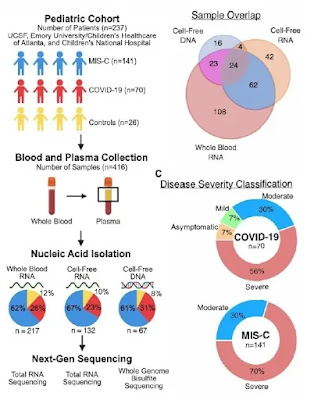Nucleic acid 2022
Overlap in pro-inflammatory genes and pathways between COVID-19 and MIS-C
Background
To date, COVID-19 and MIS-C, both
caused by severe acute respiratory syndrome coronavirus 2 (SARS-CoV-2), have
claimed more lives of children than pediatric mortality from influenza. Both
these diseases manifest highly inflammatory states and have distinct signatures
of cell injury and cell death, with more heterogeneity and multi-organ
involvement observed in MIS-C.
Further, both these diseases show
different levels of expression for some genes, including interferon-stimulated
gene 15 (ISG15), sialoadhesin (SIGLEC1), and T Cell receptor
beta variable 11-2 (TRBV11-2). Previous studies have also shown specific
downregulation of T cell-mediated pathways in MIS-C. Furthermore, MIS-C has overlapping clinical
symptoms with other inflammatory syndromes, such as Kawasaki disease (KD),
making its diagnosis difficult.
About
the study
In the present study, researchers collected blood
and plasma samples from children at three pediatric hospitals in the United
States (US). They stratified all samples by diagnosis, collection time, and
disease severity. They used plasma samples for cfRNA and cfDNA profiling using
next-generation sequencing (NGS).
Likewise, they performed RNA-seq on
wbRNA and compared wbRNA and cfRNA profiles from 96 paired samples in MIS-C and
COVID-19. Lastly, they implemented BayesPrism and the Tabula Sapiens human
single-cell transcriptome atlas as a reference to quantify cell-types-of-origin
(CTO) of the cfRNA. The study cohort comprised 211 children diagnosed with
COVID-19 or MIS-C and 26 controls.
Study
findings
The researchers identified signatures
associated with cellular injury and death that distinguished MIS-C and COVID-19
and the involvement of previously unreported cell types in MIS-C using plasma
cfRNA profiling. Plasma cfDNA profiling uncovered the involvement of multiple
organs in MIS-C compared to COVID-19 and controls. On the other hand, the wbRNA
analysis revealed a substantial overlap in pro-inflammatory pathways between MIS-C
and COVID-19. In addition, it revealed pro-inflammatory pathways specific to
each disease state. Together, these results provided new insights into the
differential pathogenesis of MIS-C and COVID-19 to inform the development of
the least invasive diagnostic tests for both acute COVID-19 and MIS-C.
Conclusions
The current large, multi-hospital
study of 416 blood samples from 237 patients reported a longitudinal analysis
of COVID-19 and MIS-C by deep sequencing of three nucleic acids, cfRNA, wbRNA,
and cfDNA. Longitudinal sampling of these cell-associated and cell-free nucleic
acids at acute, post-acute, one-month, and three post-hospitalization
timepoints enabled a complete view of immune responses and tissue damage
associated with MIS-C and COVID-19.
In wbRNA profiling, the researchers
observed an opposing dynamics of the disintegrin and metalloproteinase with
thrombospondin motifs (ADAMTS2) in MIS-C and COVID-19. While elevated ADAMTS2
levels returned to baseline in MIS-C at one-month post-hospitalization, the
same did not occur in COVID-19 patients. Similarly, killer cell lectin-like
receptor subfamily B, member 1 (KLRB1) levels in MIS-C recovered at one-month
post-hospitalization but not in COVID-19. Despite the initial severity, most
clinical MIS-C symptoms resolved within a few weeks, and inflammatory and
injury biomarkers normalized. In cfRNA profiling, most biomarker measurements,
such as CTO values, persisted at one month but returned to baseline after three
months of hospitalization.
Source: https://4dg2.short.gy/Newsnucleic
Conference
name: 6th International Conference on Molecular Biology and Nucleic Acids
Short
Name: Nucleic acid 2022
Place: Chicago,
USA
Date: August
15-16, 2022
Visit on our
Website: https://www.lexismeeting.com/nucleicacids
Whatsapp: +44-7360-516157
Email: nucleicacids@eventqueries.com




Comments
Post a Comment